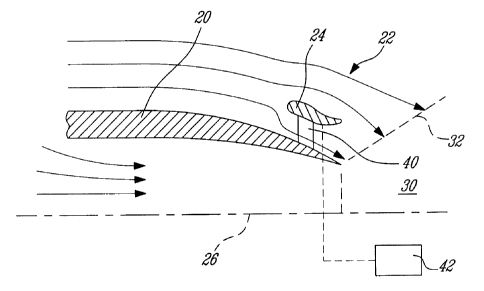Some of the information on this Web page has been provided by external sources. The Government of Canada is not responsible for the accuracy, reliability or currency of the information supplied by external sources. Users wishing to rely upon this information should consult directly with the source of the information. Content provided by external sources is not subject to official languages, privacy and accessibility requirements.
Any discrepancies in the text and image of the Claims and Abstract are due to differing posting times. Text of the Claims and Abstract are posted:
| (12) Patent: | (11) CA 2666190 |
|---|---|
| (54) English Title: | NACELLE DRAG REDUCTION DEVICE FOR A TURBOFAN GAS TURBINE ENGINE |
| (54) French Title: | DISPOSITIF DE REDUCTION DE TRAINEE DE NACELLE POUR UN MOTEUR DE TURBINE A GAZ A TURBO REACTEUR |
| Status: | Deemed expired |
| (51) International Patent Classification (IPC): |
|
|---|---|
| (72) Inventors : |
|
| (73) Owners : |
|
| (71) Applicants : |
|
| (74) Agent: | NORTON ROSE FULBRIGHT CANADA LLP/S.E.N.C.R.L., S.R.L. |
| (74) Associate agent: | |
| (45) Issued: | 2013-01-29 |
| (86) PCT Filing Date: | 2007-10-10 |
| (87) Open to Public Inspection: | 2008-05-22 |
| Examination requested: | 2009-04-08 |
| Availability of licence: | N/A |
| (25) Language of filing: | English |
| Patent Cooperation Treaty (PCT): | Yes |
|---|---|
| (86) PCT Filing Number: | PCT/CA2007/001812 |
| (87) International Publication Number: | WO2008/058368 |
| (85) National Entry: | 2009-04-08 |
| (30) Application Priority Data: | ||||||
|---|---|---|---|---|---|---|
|
The nacelle drag reduction device (22) comprises a substantially circular and axis symmetrical external airfoil (24) concentric with a aft section of the nacelle (20) and located outside a propulsive jet zone (30) defined behind the engine (10) when operating, the airfoil (24) being positioned at a location providing a maximum streamline angle with reference to the main axis (26) of the engine (10) and a highest streamline curvature.
L'invention concerne un dispositif de réduction de traînée de nacelle (22) qui comprend un plan de sustentation (24) externe sensiblement circulaire à symétrie axiale, concentrique à une section arrière de la nacelle (20) et situé à l'extérieur d'une zone de jet de propulsion (30) définie derrière le moteur (10) lors du fonctionnement, le plan de sustentation (24) étant positionné à un emplacement où il forme un angle aérodynamique maximal par rapport à l'axe principal (26) du moteur (10) et à une courbure aérodynamique la plus élevée.
Note: Claims are shown in the official language in which they were submitted.
Note: Descriptions are shown in the official language in which they were submitted.

For a clearer understanding of the status of the application/patent presented on this page, the site Disclaimer , as well as the definitions for Patent , Administrative Status , Maintenance Fee and Payment History should be consulted.
| Title | Date |
|---|---|
| Forecasted Issue Date | 2013-01-29 |
| (86) PCT Filing Date | 2007-10-10 |
| (87) PCT Publication Date | 2008-05-22 |
| (85) National Entry | 2009-04-08 |
| Examination Requested | 2009-04-08 |
| (45) Issued | 2013-01-29 |
| Deemed Expired | 2020-10-13 |
There is no abandonment history.
| Fee Type | Anniversary Year | Due Date | Amount Paid | Paid Date |
|---|---|---|---|---|
| Request for Examination | $200.00 | 2009-04-08 | ||
| Application Fee | $400.00 | 2009-04-08 | ||
| Maintenance Fee - Application - New Act | 2 | 2009-10-13 | $100.00 | 2009-10-08 |
| Maintenance Fee - Application - New Act | 3 | 2010-10-12 | $100.00 | 2010-10-12 |
| Maintenance Fee - Application - New Act | 4 | 2011-10-11 | $100.00 | 2011-09-14 |
| Maintenance Fee - Application - New Act | 5 | 2012-10-10 | $200.00 | 2012-08-17 |
| Final Fee | $300.00 | 2012-11-16 | ||
| Maintenance Fee - Patent - New Act | 6 | 2013-10-10 | $200.00 | 2013-09-13 |
| Maintenance Fee - Patent - New Act | 7 | 2014-10-10 | $200.00 | 2014-09-17 |
| Maintenance Fee - Patent - New Act | 8 | 2015-10-13 | $200.00 | 2015-09-24 |
| Maintenance Fee - Patent - New Act | 9 | 2016-10-11 | $200.00 | 2016-09-21 |
| Maintenance Fee - Patent - New Act | 10 | 2017-10-10 | $250.00 | 2017-09-20 |
| Maintenance Fee - Patent - New Act | 11 | 2018-10-10 | $250.00 | 2018-09-21 |
| Maintenance Fee - Patent - New Act | 12 | 2019-10-10 | $250.00 | 2019-09-20 |
Note: Records showing the ownership history in alphabetical order.
| Current Owners on Record |
|---|
| PRATT & WHITNEY CANADA CORP. |
| Past Owners on Record |
|---|
| ALECU, DANIEL T. |